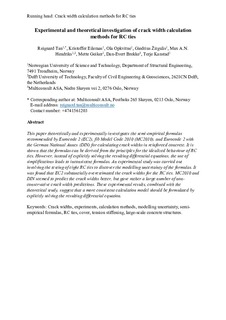| dc.contributor.author | Tan, Jesus Reignard Medel | |
| dc.contributor.author | Eileraas, Kristoffer | |
| dc.contributor.author | Opkvitne, Ola | |
| dc.contributor.author | Zirgulis, Giedrius | |
| dc.contributor.author | Hendriks, Max | |
| dc.contributor.author | Geiker, Mette Rica | |
| dc.contributor.author | Brekke, Dan-Evert | |
| dc.contributor.author | Kanstad, Terje | |
| dc.date.accessioned | 2018-12-12T09:15:42Z | |
| dc.date.available | 2018-12-12T09:15:42Z | |
| dc.date.created | 2018-07-05T07:54:20Z | |
| dc.date.issued | 2018 | |
| dc.identifier.citation | Structural Concrete. 2018, 19 (5), 1436-1447. | nb_NO |
| dc.identifier.issn | 1464-4177 | |
| dc.identifier.uri | http://hdl.handle.net/11250/2577297 | |
| dc.description.abstract | This paper theoretically and experimentally investigates the semi-empirical formulas recommended by Eurocode 2 (EC2), fib Model Code 2010 (MC2010), and Eurocode 2 with the German National Annex (DIN) for calculating crack widths in reinforced concrete. It is shown that the formulas can be derived from the principles for the idealized behavior of RC ties. However, instead of explicitly solving the resulting differential equations, the use of simplifications leads to inconsistent formulas. An experimental study was carried out involving the testing of eight RC ties to discover the modeling uncertainty of the formulas. It was found that EC2 substantially overestimated the crack widths for the RC ties. MC2010 and DIN seemed to predict the crack widths better, but gave rather a large number of nonconservative crack width predictions. These experimental results, combined with the theoretical study, suggest that a more consistent calculation model should be formulated by explicitly solving the resulting differential equation. | nb_NO |
| dc.language.iso | eng | nb_NO |
| dc.publisher | Wiley | nb_NO |
| dc.title | Experimental and theoretical investigation of crack width calculation methods for RC ties | nb_NO |
| dc.title.alternative | Experimental and theoretical investigation of crack width calculation methods for RC ties | nb_NO |
| dc.type | Journal article | nb_NO |
| dc.type | Peer reviewed | nb_NO |
| dc.description.version | acceptedVersion | nb_NO |
| dc.source.pagenumber | 1436-1447 | nb_NO |
| dc.source.volume | 19 | nb_NO |
| dc.source.journal | Structural Concrete | nb_NO |
| dc.source.issue | 5 | nb_NO |
| dc.identifier.doi | 10.1002/suco.201700237 | |
| dc.identifier.cristin | 1595752 | |
| dc.relation.project | Statens Vegvesen: 25135401 | nb_NO |
| dc.description.localcode | Locked until 4.7.2019 due to copyright restrictions. This is the peer reviewed version of the article which has been published in final form at [https://doi.org/10.1002/suco.201700237]. This article may be used for non-commercial purposes in accordance with Wiley Terms and Conditions for Self-Archiving. | nb_NO |
| cristin.unitcode | 194,64,45,0 | |
| cristin.unitname | Institutt for konstruksjonsteknikk | |
| cristin.ispublished | true | |
| cristin.fulltext | original | |
| cristin.fulltext | postprint | |
| cristin.qualitycode | 1 | |
